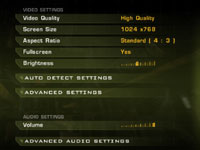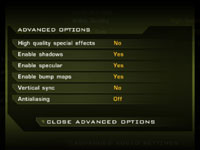24" Widescreen Gaming:
For gameplay evaluations on a CRT monitor, please head straight to our CRT performance section.Quake 4
Publisher: ActivisionWe used the full retail version of Quake 4 patched to version 1.3.0. It is the fourth game in the Quake series, based on the technically sound Doom 3 engine. However, unlike Doom 3, we found that the game benefits from at least 2x anti-aliasing, and the experience with anti-aliasing at a slightly lower resolution was better than increasing the resolution with no AA applied.
Both anti-aliasing and anisotropic filtering were controlled from inside the game. When you select "High Quality" mode, 4xAF is automatically enabled, and when the "Ultra Quality" mode is enabled, 8xAF is automatically applied to the scene. We forced anisotropic filtering values via the console using "image_anisotropy".
We did a manual run through from a five minute section of the Nexus Hub Tunnels level and found that a minimum of 15 frames per second and an average of 45-50 frames per second in our test section was deemed to be playable across the rest of the title.


We had to turn off specular lighting, which meant that the lighting wasn’t quite as effective but at least we still had the shadows turned on. We also had to reduce the texture quality to ‘medium’, which meant that high quality special effects were also disabled. The gaming experience was nowhere near as immersive as we found it on the BFG Tech GeForce 7900 GS OC, but the frame rates were adequate enough to enjoy the game.
With the BFG Tech GeForce 7900 GS OC, we were able to leave high quality textures enabled, along with specular lighting and high quality special effects. Although we didn’t have any anti-aliasing enabled, the gaming experience delivered by the card was pretty incredible with all things considered. There was simply no competition between the Radeon X1950 Pro and GeForce 7900 GS OC in this title at high resolution.

MSI MPG Velox 100R Chassis Review
October 14 2021 | 15:04











Want to comment? Please log in.